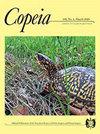蜥蜴鱼及其盟友的海洋生境转变和体型进化(Auloiformes)
IF 2.6
Q2 Agricultural and Biological Sciences
引用次数: 6
摘要
本研究采用几何形态计量学和特征进化方法研究了拟形目动物体型变化和生境转变的进化模式。蜥形鱼类;(289种)生活在从珊瑚礁到深海的各种海洋栖息地,并表现出各种各样的身体形态。在此,我们研究了44属38科的400多只拟鸟标本,发现在整个拟鸟辐射区,体型变化的模式与栖息地相吻合。在分布于近海底栖动物和深海底栖动物环境(如底栖动物科、深海底栖动物科、深海底栖动物科)的潜形动物中,梭形(鱼雷形)体占主导地位。分布在200 ~ 4000米深的深海中上层生境的类群(如:刺尾科、刺尾科、刺尾科、副刺尾科)有身体伸长的趋势,而深底栖的刺尾科(三足鱼类)则有身体伸长的趋势,背鳍和肛鳍的位置更集中。此外,与近海底栖和深海环境中发现的拟形动物相比,深海中上层拟形动物的体型差异差异最大,形状差异显著。深海底栖动物的体型变异和差异也明显高于近海底栖动物。我们发现,当翼形谱系过渡到不同的海洋栖息地时,体型发生了相当大的变化。我们推测拟音形类的共同祖先生活在深海底栖环境中,在拟音形类(蜥蜴鱼、旗鳍鱼)的共同祖先中有一次向近岸底栖环境过渡,在拟音形类的共同祖先中有两次独立向深海中上层环境过渡,一次是在拟音形类的共同祖先中,一次是在拟音形和拟音形的共同祖先中。这是第一个定量调查海洋环境中深海到珊瑚礁栖息地转变相关的拟形鱼类体型变化的研究。我们的研究结果表明,在深海中上层和底栖动物栖息地中,拟形体计划广泛多样化,而在近岸底栖动物栖息地中,拟形体计划相对保守。本文章由计算机程序翻译,如有差异,请以英文原文为准。
Marine Habitat Transitions and Body-Shape Evolution in Lizardfishes and Their Allies (Aulopiformes)
In this study, we use a geometric morphometric and a character evolution approach to study the evolutionary patterns of body-shape change and habitat transition in the Aulopiformes. Aulopiform fishes (lizardfishes; 289 spp.) inhabit diverse marine habitats from coral reefs to the deep sea and exhibit a wide range of body morphologies. Herein, we examine over 400 aulopiform specimens representing 38 of 44 genera and all families and identify that there are distinct patterns of body-shape change across the aulopiform radiation that coincide with habitat. A fusiform (torpedo-shaped) body is predominant among aulopiforms distributed in inshore-benthic and deep-sea benthic environments (e.g., Aulopidae, Bathysauridae, Synodontidae). There is a trend towards body elongation in taxa distributed in deep-sea pelagic habitats at depths of 200–4,000 meters (e.g., Alepisauridae, Lestidiidae, Notosudidae, Paralepididae) and a trend of body elongation with more centrally positioned dorsal and anal fins in the deep-benthic family Ipnopidae (tripodfishes). Additionally, deep-sea pelagic aulopiforms exhibit the largest variance in body-shape disparity with significant shape disparity compared to aulopiforms found in inshore-benthic and deep-sea environments. Deep-sea benthic lineages also have significantly higher body-shape variance and disparity compared to inshore-benthic lineages. We identify that there are considerable changes in body shape as aulopiform lineages transitioned to differing marine habitats. We infer the common ancestor of aulopiforms to have lived in a deep-sea benthic environment with a single transition to an inshore-benthic environment in the common ancestor of the Aulopoidei (lizardfishes, flagfin fishes) and two independent transitions into deep-sea pelagic environments, once in the common ancestor of Giganturidae, and once in the common ancestor of Alepisauroidea + Notosudoidea. This is the first study to quantitatively investigate changes in the body shape of aulopiform fishes tied to habitat transitions in marine environments from the deep sea to coral reefs. Our findings suggest that aulopiform body plans have broadly diversified in deep-sea pelagic and benthic habitats while remaining comparatively conservative in inshore-benthic habitats.
求助全文
通过发布文献求助,成功后即可免费获取论文全文。
去求助
来源期刊

Copeia
生物-动物学
CiteScore
2.10
自引率
0.00%
发文量
0
审稿时长
6-12 weeks
期刊介绍:
Founded in 1913, Copeia is a highly respected international journal dedicated to the publication of high quality, original research papers on the behavior, conservation, ecology, genetics, morphology, evolution, physiology, systematics and taxonomy of extant and extinct fishes, amphibians, and reptiles. Copeia is published electronically and is available through BioOne. Articles are published online first, and print issues appear four times per year. In addition to research articles, Copeia publishes invited review papers, book reviews, and compiles virtual issues on topics of interest drawn from papers previously published in the journal.
 求助内容:
求助内容: 应助结果提醒方式:
应助结果提醒方式:


